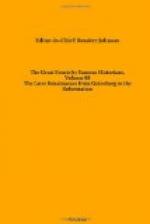The other case was diabolical. Gaspar de Santa Cruz escaped to Toulouse, where he died and was buried after his effigy had been burned in Saragossa. In this city lived a son of his, who, in duty bound, had helped him to make good his retreat. This son was delated as an impeder of the Holy Office, arrested, brought out at an act of faith, made to read a condemnation of his deceased father, and then sent to the inquisitor at Toulouse, who took him to his father’s grave, and compelled him to dig up the corpse and burn it with his own hands. Whether the inquisitors were most barbarous or the young man most vile, it may be difficult to say. But it is a most infamous glory of the Inquisition that, for satisfaction of its own requirements, the express laws of God and man and the first instincts of humanity are equally set at naught.
The Arch-inquisitor of Spain, shortly after his accession to the office, summoned the subalterns from their stations to meet him at Seville, and framed, with them, a set of instructions for uniform administration. They were published, twenty-eight in number, on October 29, 1484. On January 9, 1485, eleven more were added. The spirit of these instructions pervades the Directory of Eymeric, into which they were incorporated by his commentator. It is only important to mention here that on the present occasion an agent was appointed to represent this Inquisition at Rome, and there to defend the inquisitors on occasion of appeals from the subjects of inquisitorial violence or from their friends or their survivors. And this was in spite of a bull sent into Spain two years before, appointing the Archbishop of Seville sole judge of such appeals. But that bull was a mere feint for conciliation and never acted on at Rome.
We must not fail to mark this point in the history, forasmuch as here begins the practically juridical relation between the court of Rome as supreme, and the provinces of the Roman Church as subordinate, in matters concerning inquisition.
JAMES BALMES
As to the Spanish Inquisition, which was only an extension of that which was established in other countries, we must divide it, with respect to its duration, into three great periods. We omit the time of its existence in the kingdom of Aragon, before its introduction into Castile. The first of these comprehends the time when the Inquisition was principally directed against the relapsed Jews and Moors, from the day of its installation under the Catholic sovereigns till the middle of the reign of Charles V. The second extends from the time when it began to concentrate its efforts to prevent the introduction of Protestantism into Spain until that danger entirely ceased; that is, from the middle of the reign of Charles V till the coming of the Bourbons. The third and last period is that when the Inquisition was limited to repress infamous crimes and exclude the philosophy of Voltaire; this period was continued until its abolition, in the beginning of the nineteenth century.




